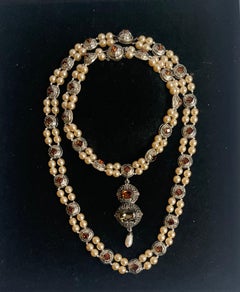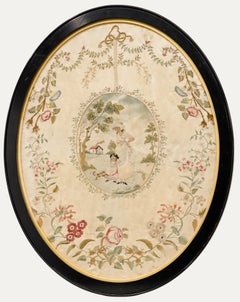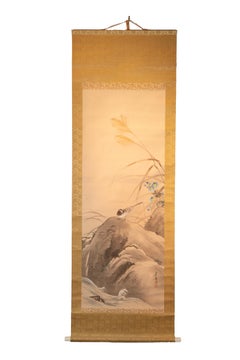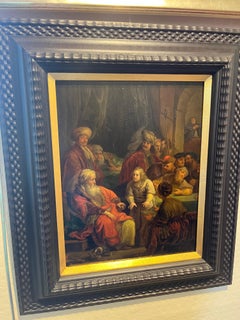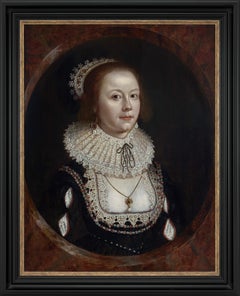18th Century and Earlier More Art
to
21
77
14
18
15
14
Overall Width
to
Overall Height
to
138
566
4,411
9,755
86
69
269
286
133
309
369
383
419
1,170
72
16
7
2
76
36
4
7
4
3
3
2
2
2
1
1
1
1
1
1
1
1
32
27
21
21
16
3
2
2
1
1
8
1
92
45
Period: 18th Century and Earlier
The Necklace of Jane Seymour, Henry VIII's Third Wife, Limited Edition, Signed
Located in New York, NY
Hiroshi Sugimoto
The Necklace of Jane Seymour, Henry VIII's Third Wife, 2000
Limited Edition Signed pendant of silver-plated brass, imitation pearls, Swarovski glass stones, handmade...
Category
Old Masters 18th Century and Earlier More Art
Materials
Metal
Georgian Embroidery - Family Walk
Located in Corsham, GB
A charming Georgian silk embroidery panel depicting a mother and child walking through the countryside, accompanied by their faithful dog. Exe...
Category
18th Century and Earlier More Art
Materials
Tapestry
'Bird on Rock with Blue Flowers', By Unknown, Chinese Antique Scroll
Located in Oklahoma City, OK
This 59" x 20" Chinese Antique Scroll depicts a simple yet serene scene of a bird on a rock. The bird stands on the rock, which is much larger in size in comparison to the bird. The ...
Category
Qing 18th Century and Earlier More Art
Materials
Silk, Paper, Watercolor
$140 Sale Price
20% Off
Seventeenth Century Old Master Biblical Oil Painting Joseph recounts his Dream
Located in ludlow, GB
Seventeenth Century Old Master Biblical themed Oil Painting on Panel of Joseph recounting his Dream. A Follower of Rembrandt Harmensz Van Rijn 1606 - 1669. This painting follows a ...
Category
Old Masters 18th Century and Earlier More Art
Materials
Oil
Portrait of lady, Mary Hammond in Rich Attire, Jewels, Lace c.1618-22 Historical
By Cornelius Johnson
Located in London, GB
Portrait of Mary Hammond in Sumptuous Attire, Jewels and Lace c.1618-22
Circle of Cornelius Johnson (1593-1661)
This portrait of a lady, presented by Titan Fine Art, is an exquisite...
Category
Old Masters 18th Century and Earlier More Art
Materials
Oil, Panel
Nova Totius Terrarum Orbis Geographica Ac Hydrographica Tabula
Located in New York, NY
Copper-plate engraving, hand-colored, 1608 - c.1630 and published by Joannes Jansonius, Amsterdam. Image size 15.75 x 21.19 inches (40 x 53.9 cm).
A classic example of a world ma...
Category
Other Art Style 18th Century and Earlier More Art
Materials
Engraving
Portrait of a Lady, Mrs Wray in a Silk Dress & Pink Wrap c.1698, Oil on canvas
By Michael Dahl
Located in London, GB
Portrait of a Lady, Mrs Wray in a Silk Dress & Pink Wrap c.1698
Circle of Michael Dahl (1659-1743)
This delightful work, presented by Titan Fine Art, is a fine example of British po...
Category
Old Masters 18th Century and Earlier More Art
Materials
Cotton Canvas, Oil
Portrait of Lady, Barbara Herbert, Countess of Pembroke c.1708, Large Painting
Located in London, GB
Portrait of Barbara Herbert, Countess of Pembroke c.1708
Charles d’Agar (1669-1723)
This magnificent large-scale portrait, presented by Titan Fine Art, depicts the British court of...
Category
Old Masters 18th Century and Earlier More Art
Materials
Cotton Canvas, Oil
Chimu Inca c.1500 Peruvian terra-cotta anthropomorphic face vase vessel Peru
Located in Wilton Manors, FL
Beautiful antique Peruvian face vessel. Chimu Inca, c.1500 Terracotta, measures h. 8 in., w. 4 7/8 inches. No repair or conservation.
Category
18th Century and Earlier More Art
Materials
Terracotta
$720 Sale Price
60% Off
Majolica Plate by Castelli. The Miracle Of The Loaves And Fishes. 18 century
Located in Firenze, IT
Castles of Abruzzo.
Italian Maiolica, dish with the Miracle of the loaves and fishes.
Mid-18th century.
Polychrome tin-glazed majolica painted by hand.
Castles, Abruzzo, mid-18th c...
Category
Italian School 18th Century and Earlier More Art
Materials
Maiolica, Ceramic
Antique Chinese Four Leaf Panel Hand-Painted Lacquer Screen
Located in Cirencester, Gloucestershire
Antique Chinese Four-Panel Lacquer Screen with Scenic Landscape
Description:
This exquisite antique Chinese four-panel lacquer screen is a remarkable example of traditional craftsma...
Category
18th Century and Earlier More Art
Materials
Wood
$2,786 Sale Price
30% Off
Vintage Moth II (Hand-Painted, Gold Luster, Vintage Imagery)
Located in Kansas City, MO
Melanie Sherman
Vintage Moth II (Hand-Painted, Gold Luster, Vintage Imagery)
Porcelain, Glaze, Overglaze, Chinapaints, 24k German Gold Luster
Year: 2025
Size: 4.5 x 6 x 0.5 inches
Si...
Category
Victorian 18th Century and Earlier More Art
Materials
Luster, Porcelain, Paint, Glaze
Limestone Relief With Saint Georges, France 15th Century
Located in Milan, IT
Relief with saint Georges
France, 15th Century
limestone 26 x 20 cm (10 1/4 x 7 3/4 in) without base
Category
18th Century and Earlier More Art
Materials
Limestone
"Roman Mosaic", Tiger hunting for its prey, 4th Century AD North Africa Province
Located in Madrid, ES
ROMAN MOSAIC
Roman 4th Century AD
Roman Provinces of North Africa
A TIGER HUNTING ITS PREY
40-1/4 x 84-1/4 inches (102 x 213 x 2.5 cm.)
Within an iron metal frame
PROVENANCE
Nagel A...
Category
18th Century and Earlier More Art
Materials
Mosaic
Flemish Old Master, Study of Donkey Carriage, 17th Century, Sanguine Drawing
Located in Greven, DE
This drawing shows several studies of a donkey with a carriage. Its style is close to Flemish 17th century artists. On the passepartout one reads "Mathias Scheyer/ Jacob Weyer", both...
Category
Baroque 18th Century and Earlier More Art
Materials
Chalk, Handmade Paper
$851 Sale Price
20% Off
European Portrait of a Priest
Located in Milford, NH
A fine European portrait of a priest, oil on canvas, probably dating to the 17th or 18th century, unsigned, with original stretcher, minor surface losses and damage, craquelure, edge...
Category
18th Century and Earlier More Art
Materials
Canvas, Oil
Georgian Embroidery - A Rest by the River
Located in Corsham, GB
A charming Georgian silk embroidery panel depicting a young lady and her faithful dog resting by the river. Executed with remarkable skill, th...
Category
18th Century and Earlier More Art
Materials
Tapestry
Portrait of Gentleman, Sir Henry Hobart, Blue Cloak & cravat, Wissing oil canvas
By Willem Wissing
Located in London, GB
Portrait of a Gentleman, Sir Henry Hobart Blue Cloak and cravat c.1683-1684
Attributed to Willem Wissing (1656-1687)
This impressive portrait, presented by Titan Fine Art, depicts t...
Category
Old Masters 18th Century and Earlier More Art
Materials
Cotton Canvas, Oil
Anne Salmon - Fine 1791 Embroidery, The Cheerful Voyagers
Located in Corsham, GB
An exceptionally fine Georgian embroidery by Anne Salmon depicting 'Cheerful Voyagers' punting in the serene English countryside. Executed with rem...
Category
18th Century and Earlier More Art
Materials
Tapestry
Portrait of Gentleman in blue, Portrait of Lady, oval pair Fine Carved Frames
Located in London, GB
Portrait of a Gentleman with Blue Cloak and Portrait of a Lady in Russet Dress c.1697
Thomas Murray (1663-1735)
These fascinating portraits are exquisite examples of portraiture in ...
Category
Old Masters 18th Century and Earlier More Art
Materials
Oil, Canvas
Portrait Gentleman Armour, Blue Cloak, Diamond Brooch c.1700 French Carved Frame
By Joseph Vivien
Located in London, GB
Portrait of a Gentleman in Armour and Azure Cloak with Diamond Brooch c.1700
Attributed to Joseph Vivienne (1657-1735)
The sitter in this superb portrait, offered by Titan Fine Art...
Category
Old Masters 18th Century and Earlier More Art
Materials
Oil, Cotton Canvas
Baroque wax religious figurative bas-relief from the 18th century
Located in Florence, IT
Polychrome wax relief on chalkboard, 20 x 15 cm; with ebony and tortoiseshell frame, 28 x 23 cm
The scene depicts Mary Magdalene in the center, seated on a rock with a handkerchief i...
Category
Baroque 18th Century and Earlier More Art
Materials
Slate
Mother Goddess Figurine, Early Indus Valley Civilization (circa 3500 - 2800 BC)
Located in Paris, Île-de-France
Mother Goddess Figurine
Early Indus Valley Civilization (circa 3500 - 2800 BC)
Handmade pottery, 140 mm x 45 mm, 60 g
Provenance:
Prince Collection, 1990s-2014;
Pierre Bergé Colle...
Category
Tribal 18th Century and Earlier More Art
Materials
Clay, Terracotta
LARGE ITALIAN RENAISSANCE MARBLE CAPITAL, 15th/16th Century
Located in Milan, IT
LARGE ITALIAN RENAISSANCE MARBLE CAPITAL
Florence, 15th/16th Century
marble
38 x 47 x 47 cm
15 x 18 1/2 x 18 1/2 in
Category
18th Century and Earlier More Art
Materials
Marble
Portrait of a Gentleman, David Erskine, 13th Laird of Dun, Wearing Armour c.1700
Located in London, GB
The gentleman in this exquisite oil on canvas portrait, presented by Titan Fine Art, is shown with the grandiloquence characteristic of the English School of painting. He is portray...
Category
Old Masters 18th Century and Earlier More Art
Materials
Oil, Canvas
Ancient Arabic Calligraphy of Praying
Located in Roma, IT
Arabic Calligraphy of praying is a precious manuscript reporting Islamic Sacred Verses in an ancient calligraphy style.
One page, one-sided, in Ara...
Category
18th Century and Earlier More Art
Materials
Ink
Francesco Albani Circle Italian Mythological Painting
Located in Roma, IT
Francesco Albani Circle Italian Mythological Painting
This important oil painting on wood depicts a subject that is very rare in the iconography of ancient mythological paintings: the birth of Erittonio. Erichthonius who succeeded Amphictyon becoming the fourth mythological king of Athens and married the naiad Praxithea who made him the father of Pandion.
The extremely high quality of this very rare painting suggests that it was painted by an artist who frequented Francesco Albani's studio.
The period, the mythological subject, the harmony of the colours and, above all, the sublime quality of the flesh tones all point in this direction.
This artwork, never before on the market, comes from an important Italian private collection
Every item of our Gallery, upon request, is accompanied by a certificate of authenticity issued by Sabrina Egidi official Expert in Italian furniture for the Chamber of Commerce of Rome and for the Rome Civil Courts.
ERYTHTONIOS (᾿Ερυχϑόνιος, Erychthonios)
Born of Hephaestus' love for Athena, from the breast of Ghe, who was impregnated by the god; welcomed by Athena, who placed him in a basket together with one or two snakes, entrusting him to the care of Cecrops' three daughters.
Against the goddess's wishes, they opened the chest, from which emerged, according to different versions of the myth, either the child wrapped in snakes or a snake, which, in some versions, killed the girls, while in others, they threw themselves from the Acropolis in fear. Erittonio, in the form of a snake, is welcomed by Athena into her temple and curls up under the goddess's shield. Alongside this myth, of Ionian origin, are others due to the doubling of the figures of E. and Erechtheus
The scene of the birth appears in figurative tradition: in a Melian terracotta relief from the early 5th century, Ghe, half-emerging, holds out the baby Erittonio. to Athena, who welcomes him in the presence of Cecrops; the same scene appears on various painted vases, such as a red-figure kölix by the Painter of Kodros, from Tarquinia, in the Berlin Museums, dating from around 440 BC, where Hephaestus also appears alongside Cecrops.
A modest red-figure vase from Camiro, in the British Museum, depicts the moment when the fleeing Cecropids discover the cista, from which the infant Erittonio. emerges between two snakes, greeting Athena.
The moment when the chest was opened was depicted by Phidias on the xiii and xiv S metopes of the Parthenon, where Cecrops and Pandrosus appear in the first and Erisichthon and Aglaurus with the chest uncovered in the second.
A kölix in the style of the Brygos Painter in Frankfurt, on the other hand, depicts the large snake E. chasing the fleeing Cecropids towards their father's palace.
Luciano (De dom., 27) recalls a painting depicting the scene of the birth and the representation of the myth in pantomime on the theatre (De salt., 39).
Bibliography: Engelmann, in Roscher, cc. 1303-1308, s. v. Erichthonios; P. Jacobstahl, Die Melischen Reliefs, Berlin 1931, pp. 96-98, plate 75 a; W. Züchner, in Jahrbuch, LXV-LXVI, 1950-51, p. 200 ff., figs. 34-35; J. D. Beazley, Red-fig., p. 720; G. Becatti, Problemi fidiaci, Florence 1951, p. 22.
Questo
Francesco Albani (Bologna, August 17, 1578 – Bologna, October 4, 1660) was an Italian painter.
Albani was born in Bologna, Papal States, in 1578.
His father was a silk merchant who intended his son to go into his own trade. By the age of twelve, however, he had become an apprentice to the competent mannerist painter Denis Calvaert, in whose studio he met Guido Reni. He soon followed Reni to the so-called "Academy" run by Annibale, Agostino, and Ludovico Carracci.
This studio fostered the careers of many painters of the Bolognese school, including Domenichino, Massari, Viola, Lanfranco, Giovanni Francesco Grimaldi...
Category
Old Masters 18th Century and Earlier More Art
Materials
Oil, Wood Panel
Night Thoughts - Rare Book Illustrated by Sir William Blake - 1797
Located in Roma, IT
Night Thoughts is an original Modern Rare book written by Edward Young (1683 – 1765) and engraved by Sir William Blake (London, 1757 - London, 1827) in 1797.
It includes a suite of ...
Category
Modern 18th Century and Earlier More Art
Materials
Paper, Etching
Two-Part Large Hand-Colored Map of Europe from 1798
Located in New York, NY
Map of Europe printed on two separate sheets from A New Universal Atlas by Thomas Kitchin. Published in London by Laurie & Whittle, 1798. Original engravings hand-colored at publicat...
Category
18th Century and Earlier More Art
Materials
Paper
$1,700 Sale Price
33% Off
Jerusalem, Perfume Vessel, Iron Age
Located in Milwaukee, WI
4x3
Ceramic
Ancient clay perfume jug from the Iron Age discovered in Jerusalem.
Category
18th Century and Earlier More Art
Materials
Ceramic
Burma, Thai Bronze Head of Buddha (original)
Located in Milwaukee, WI
Thai Bronze Head of Buddha (Original) 17th c.
Category
18th Century and Earlier More Art
Materials
Bronze
Dutch Old Master Portrait of Maurits, Prince of Orange-Nassau, Oil on Panel
Located in London, GB
In 1607, the Delft city council decided to commission a portrait of Stadholder Maurits of Nassau for the town hall, with Michiel van Mierevelt as the chosen artist due to the passing...
Category
Old Masters 18th Century and Earlier More Art
Materials
Oil, Wood Panel
British East Indiaman Ship Returning from a Voyage to the East
Located in Milford, NH
A large marine painting probably depicting a British East Indiaman ship returning from a voyage to the East, attributed to British artist Francis Holman ...
Category
18th Century and Earlier More Art
Materials
Canvas, Oil
The Penance of St. Chrysostom by Albrecht Dürer
Located in New Orleans, LA
Albrecht Dürer
1471-1528 German
The Penance of St. Chrysostom
Monogrammed in the plate lower center "AD"
Copper engraving on laid paper
“Whatever was mortal in Albrecht Dürer li...
Category
Old Masters 18th Century and Earlier More Art
Materials
Copper
Tuscan Mannerist bronze Mortaretto d'allegrezza from the 17th century
Located in Florence, IT
Decorated with a cartouche on which the family coat of arms was probably engraved, this interesting small bronze object is a "cheer mortar" (also called a "mascolo" or "mastio" of ch...
Category
Mannerist 18th Century and Earlier More Art
Materials
Bronze
Hand-decorated Tea Bowl (Gold Luster, Rich, Floral, Fine China)
Located in Kansas City, MO
Melanie Sherman
Hand-decorated Tea Bowl / Yunomi (Gold Luster, Rich, Floral, Fine China, Precious)
Porcelain, 24K German Gold Luster, Glaze, Underglaze, China Paints, Vintage Transfe...
Category
Rococo 18th Century and Earlier More Art
Materials
Luster, Paint, Glaze, Porcelain
ITALIAN RENAISSANCE CAPITAL WITH MYTHOLOGICAL FIGURES, 15th Century
Located in Milan, IT
ITALIAN RENAISSANCE CAPITAL WITH MYTHOLOGICAL FIGURES, 15th Century
marble
H 18 x Diam 33.5 cm
H 7 x Diam 13 1/4 in
Category
18th Century and Earlier More Art
Materials
Marble
Cuzco School Baptismal Dish
Located in New York, NY
Provenance:
Manuel Ortíz de Zevallos y García, Peru; and by descent in the family to:
Private Collection, New York.
This impressive baptismal dish is an example of eighteenth-cent...
Category
Old Masters 18th Century and Earlier More Art
Materials
Silver
Ancient Greek Terracotta Comic Actor Figurine
Located in Milan, IT
TERRACOTTA FIGURINE OF A COMIC ACTOR , Greece, c. 350 B.C.
Labeled to the reverse, 'LAWRENCE COLL./LOT 426. SOTHEBY./APR. 1892. P. 816.';
Terracotta
height 15.2 cm
height 6 in
Prove...
Category
18th Century and Earlier More Art
Materials
Terracotta, ABS
18th Century Embroidery - Beneath the Trees
Located in Corsham, GB
A delightful 18th-century woolwork depicting a couple leisurely resting in a blooming meadow beneath lush, leafy trees. The artist has expertly blended threads of green and pink to c...
Category
18th Century and Earlier More Art
Materials
Tapestry
Georgian Embroidery - Collecting Corn
Located in Corsham, GB
A delightful 18th-century embroidery depicting three sisters and their mother gathering corn. The artist has expertly employed an array of different stitches such as French knots and...
Category
18th Century and Earlier More Art
Materials
Tapestry
Georgian 18th Century Embroidery - Bouquet
Located in Corsham, GB
A delicate George III embroidery depicting a bouquet of flowers. Well presented in a gilt-effect frame with a brown mount. On silk.
Category
18th Century and Earlier More Art
Materials
Tapestry
Mother of Pearl Inlaid Wooden Occasional Table
Located in New York, NY
This occasional table is a remarkable example of the luxurious furniture popular during the 17th and 18th centuries in Colonial Latin America. The decorative technique that creates s...
Category
18th Century and Earlier More Art
Materials
Wood
14th Century Italian Marble Mortar with Animals depicted on the sides
Located in Milan, IT
Unusual 14th Century Italian marble mortar with animals depicted on the sides
Category
18th Century and Earlier More Art
Materials
Marble
Flowers In A Basket - Original Oil, Still Life, French, Franco-Flemish painter
By Jean-Baptiste Monnoyer
Located in Knowle Lane, Cranleigh
Flowers in A Basket by Jean-Baptiste Monnoyer. A Still Life of flowers in a basket including jasmine, honeysuckle, dahlias, parrot tulips, delphiniums and white carnations.
Category
Baroque 18th Century and Earlier More Art
Materials
Oil, Canvas
Dutch or Flemish Landscape with Figures & Animals
Located in Milford, NH
A beautifully detailed late 17th or early 18th century Dutch or Flemish landscape with cows grazing in the water, goats, dogs, and other animals near the water’s edge, under the watchful eye of the herdsmen, on a backdrop of rolling hills and trees. Oil on wood panel, unsigned, and housed in a Rudolph...
Category
Flemish School 18th Century and Earlier More Art
Materials
Oil, Wood Panel
Figure of a Beauty, Japan, Edo Period
Located in Palm Desert, CA
A Japanese embroidery from the Edo Period. “Figure of a Beauty” is a portrait embroidery, silk and gold thread in golds and grays.
Provenance:
Priv...
Category
Edo 18th Century and Earlier More Art
Materials
Silk
Old Master Drawing, Baroque, Jacob de Wit, Allegory of Victory, Putti, Ships
By Jacob De Wit
Located in Greven, DE
Two putti with symbols of war and victory (cannons, cannonballs, armour, anchor, lion's head, laurel branch/ olive branch, flag, staff with helmet) in pediment triangle.
Probably a design for a painting or architecture
Pen-and-ink drawing in black on brownish paper, black wash
Plain gold moulding with UV glass
Allegory of Victory, 18th Century, Old Master Drawing, By De Wit, Figurative
Jacob de Wit...
Category
Baroque 18th Century and Earlier More Art
Materials
Paper, Crayon
$2,153 Sale Price
35% Off
ANTIQUE ITALIAN LARGE CIRCULAR FRAGMENT OF A FLUTED COLUMN
Located in Milan, IT
LARGE CIRCULAR FRAGMENT OF A FLUTED COLUMN
Central Italy, 13th century
stone
Category
18th Century and Earlier More Art
Materials
Stone
Vintage Moth X (Wall Piece/Dish (hand-painted)
Located in Kansas City, MO
Melanie Sherman
Vintage Moth X (Wall Piece/Dish (hand-painted)
Porcelain, Glaze, Overglaze, Chinapaints, 24k German Gold Luster, Brass Wire (for hanging, can be removed)
Year: 2025
S...
Category
Baroque 18th Century and Earlier More Art
Materials
Brass, Wire
Gold Tang China Horse Head
Located in New Orleans, LA
This exceptional and rare rendering of a horse head, composed of gold over silver, hails from the illustrious Tang dynasty of China. The powerful Tang dynasty reigned for nearly 300 ...
Category
Other Art Style 18th Century and Earlier More Art
Materials
Gold, Silver
Nova Iconologia di Cesare Ripa Perugino - illustrated Book - 1618
Located in Roma, IT
Complete title: Nova Iconologia di Cesare Ripa Perugino Cavalier de SS. Maurition & Lazzaro Nella quale si descrivono diverse imagini di Virtu, Vitij, Affetti, Passioni humane, Arti,...
Category
Modern 18th Century and Earlier More Art
Materials
Paper
Coppia di specchi rococò toscane in legno dorato
Located in Florence, IT
Coppia di specchi rococò il legno dorato decorati a volute, racemi floreali, e mascheroni. Hanno mantenuto il loro vetro originale.
Category
Rococo 18th Century and Earlier More Art
Materials
Gold
Old Master Drawing, Roccoco, 18th Century, German Artist, Animal Drawing
By Johann Martin Metz
Located in Greven, DE
Black chalk, partly washed, on paper, sheet 27.5 x 19.7 cm
Plain gold moulding, 44.8 x 36 cm
The Rhenish still life painter Johann Martin Metz was ...
Category
Rococo 18th Century and Earlier More Art
Materials
Paper, Crayon
$757 Sale Price
20% Off
Porcelain KPM Plaque - Exquisite Saint Cecilia: Large size
Located in Jacksonville, FL
Immerse yourself in the divine beauty of Saint Cecilia with this extraordinary KPM Porcelain Portrait, meticulously crafted after Raphael’s masterpiece. This captivating artwork, hou...
Category
Victorian 18th Century and Earlier More Art
Materials
Porcelain
Old Master Drawing, Westerkerk Keizersgracht in Amsterdam, 17th century, Dutch
Located in Greven, DE
Jan van der Heyden (1637 Gorinchem - 1712 Amsterdam), attributed.
Old Master Drawing, Westerkerk Keizersgracht in Amsterdam, 17th century, Dutch
Westerkerk and Keizersgracht in Amsterdam
Backside: later drawn backside with village church of the 18th century
Chalk and pen on paper
23,5 x 18,5 cm
Preliminary drawing for a painting from the creative period c. 1667 - 1670. This painting has been published a few years ago by Peter C. Sutton in the catalogue raisonné of the artist.
Van der Heyden was initially a pupil of a glass painter, but later turned exclusively to architectural painting and went to Amsterdam, where he painted views of churches, castles, palaces, public squares, streets, canals, etc., most of which are richly decorated with staffage. In addition, van der Heyden was also active as an inventor, for example, he developed a street lighting system for Amsterdam by means of oil street lamps, which was in operation from 1669 to 1840. After a stay in London, he painted the London fire of 1666, which he either witnessed himself or had seen the consequences of. Certainly influenced by this, he did much to further the technical and organisational development of the fire brigade from 1669 onwards. His greatest invention was probably the fire hose, which enabled significant improvements in fire-fighting technology and tactics. He also improved the hand-operated fire engines of the time by making them smaller, more mobile and more powerful, and he developed the series connection of several pumps to increase the pressure in order to achieve a greater range for the water jet. In 1690, together with his son, he was the author and illustrator of the Brandspuiten-boek, the first manual for fire fighting.
Johann Lingelbach, Adriaen van de Velde and Eglon van der Neer...
Category
Dutch School 18th Century and Earlier More Art
Materials
Paper, Chalk
$1,798 Sale Price
20% Off
Venetian Frame, 17th Century Gilt Carved Wood
Located in London, GB
Venetian Frame
17th Century
Gilt carved wood
Sight size: 30 x 26 cm (The middle being the largest size)
Exterior size: 52 x 47 cm
Due to the curves of...
Category
18th Century and Earlier More Art
Materials
Wood
18th Century English Double Handle Footman
Located in Beachwood, OH
English Double Handle Footman, 18th Century
Brass
12 x 18 x 17 inches
Category
18th Century and Earlier More Art
Materials
Brass
PAIR OF ITALIAN ARCHITECTURAL BRACKETS IN PIETRA SERENA, TUSCANY, 1600 CIRCA
Located in Milan, IT
Richly decorated on the side and with finely sculpted female faces, these carved stone architectural brackets are a great example of the Tuscan production of the late 16th Century. O...
Category
18th Century and Earlier More Art
Materials
Stone
Castelli Maiolica Plaque with Medieval Castle Village Italy Mediterranean Trees
Located in Austin, TX
Ceramic Plaque: 11.5 x 11.5 inches
Solid Wood Frame: 15.5 x 15.5 inches
An exquisite Castelli Maiolica plaque, featuring a richly detailed scene of the Italian Renaissance. The cera...
Category
Renaissance 18th Century and Earlier More Art
Materials
Ceramic, Wood
Recently Viewed
View AllMore Ways To Browse
Grouse Shooting
Harry Adams
Harry Day Paintings
Harvey Parks
Hedge House
Henry Collins
Hermes Birkin Bag 15
Highland Cow Painting
Hippo Painting
Hoppe Oil
Horse And Groom Painting
Horse Hunt Painting
Horse Lady Painting
Horse Painting Gold Frame
Horse Polo Paint
Hunt Double Bunnies
Hunt Etchings
Hunt Slonem Bunnies Heart
